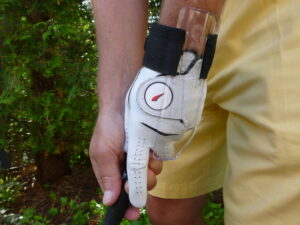Why is it that you can hit 10 controlled shots in a row at the driving range but it is difficult to hit 3 controlled shots on every hole? Your body has the ability to consistently hit balls with a variety of clubs on the range but on the course your emotion asks for a little more distance and better control. The result is often bad. Wouldn’t it be great if you could control your emotions for 18 holes?
Pros Have the Same Problem as You Do
Justin Leonard sank a 45 foot putt on the 17th hole in one of the 1999 Ryder Cup matches. He danced around the green and was pumped with adrenaline. On the next hole his drive was a duck hook. Emotion got the best of him. It was a great example of the way that emotions can mess up your game. It takes a lot of experience before you can control your emotions to win a major event or to break 90 or 80 or 70.

Tiger is on the cusp of another victory. The OPEN was within his grasp but emotion stalled his final round
Recreational Golfers Experience Emotion All the Time
If you can’t keep your emotions in check, your game will go down the drain. I was reminded that emotion must be the key factor in golf when playing a round of best ball with a 4some. One of our experienced golfers was so emotionally high strung or embarrassed that she could not hit a straight shot. She had a 20 handicap so I know that she had a reasonable game but almost every shot was topped or hit fat. Emotion got the best of her.
How Can You take Emotion out of Every Shot
1/ Be aware that EMOTION can ruin your next shot. Accept the fact that you CAN create the perfect shot and that you have made that perfect shot many times before. Always hit to a distance that is reasonable for your ability.
2/ Understand the Post-Birdie-Screw-Up: Know that your emotions are running high after a great hole or a great shot. Calm down and convince yourself that your next drive is just another shot, so relax and let it happen naturally.
3/ Simplify your swing so that you have a very limited thought process during your swing. I developed GOLFSTR+ to help me stop bending my leading arm in my backswing. Adding more backswing by bending your arm at the elbow is NOT helping consistency of your swing.
4/ Tiger and most other professional golfers learn to take their mind into a trance-like-state. They call it THE ZONE. Their total focus is on their acceleration through the ball. Use your GOLFSTR+ to train yourself to Limit Your Backswing to keep your arm straight and to cock your wrist. Swing back on one plane by coiling your body, create lag by cocking your flat leading wrist and then swing through to a balance finish. It really is that easy.
5/ Never talk about your last great hole or how low your score is for the round. That’s the kiss of death! Stay focused on your next shot or your next hole. Enjoy talking about your round after you finish it. Ben Hogan reminded us that the most important shot in golf is YOUR NEXT ONE!
6/ High Sugar Content Foods can take your emotions to a new high. Eat wisely and avoid spikes in your energy and stay hydrated. Beer and scotch is not the ideal solution.
Practice with GOLFSTR+ for success at the range and then carry that success with your CALM EMOTIONS to the course. Buy one today at www.golfstr.com<https://golfstr.com>






